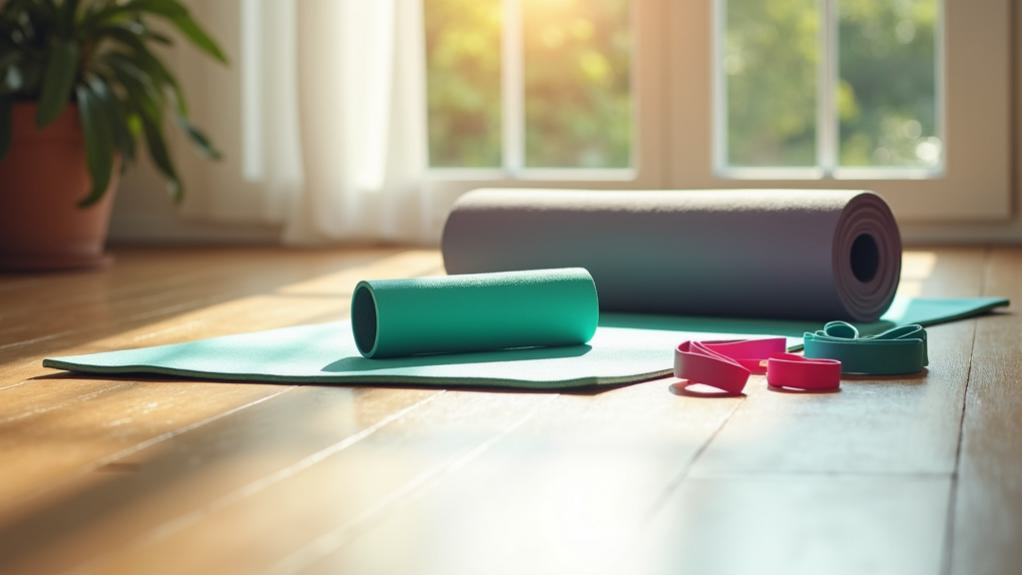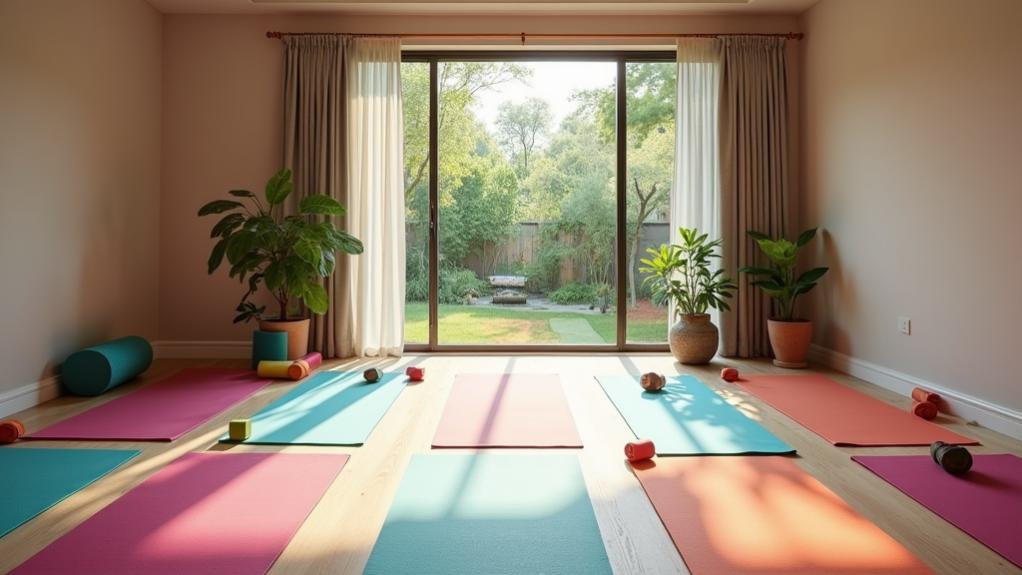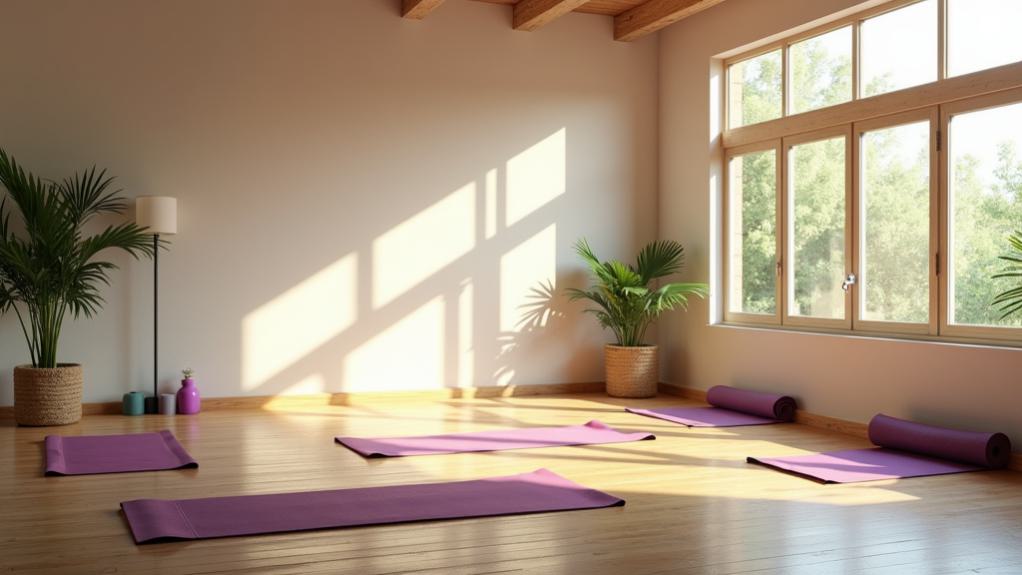Flexibility plays an essential role in enhancing your midlife fitness, enabling you to navigate daily life with ease and confidence. As you age, stiffness can increase, limiting your mobility and increasing the risk of injury. Regular stretching—3 to 4 times a week for 15-20 minutes—counteracts this decline, improving your joint range of motion and reducing discomfort. Incorporating both static and dynamic stretches can help alleviate chronic pain and promote better posture. By committing to these practices, you not only maintain independence but also boost your overall well-being. There’s so much more to explore about enhancing flexibility effectively!
Key Takeaways
- Flexibility is crucial for maintaining daily mobility and reducing injury risk as one ages, particularly after 55.
- Regular stretching 3-4 times a week helps counteract age-related stiffness and preserves joint range of motion.
- Aging leads to decreased muscle elasticity and increased stiffness, contributing to chronic aches and pains.
- Incorporating both static and dynamic stretches enhances flexibility, blood flow, and overall recovery.
- Professional guidance can create personalized stretching routines, ensuring safety and tracking progress over time.
Importance of Flexibility in Midlife
As you navigate through midlife, maintaining flexibility becomes essential for your daily activities and overall well-being. Flexibility plays an important role in your ability to perform tasks efficiently, as moderate flexibility can alleviate discomfort and greatly reduce the risk of injuries due to muscle imbalances.
With aging, it’s common to experience reduced mobility and increased stiffness, making flexibility exercises critical for preserving your independence and quality of life.
Incorporating stretching into your routine three to four times a week for just 15-20 minutes can effectively counteract age-related stiffness and enhance your joint range of motion. Regular stretching not only improves your physical capabilities but also promotes muscular coordination by resetting your central nervous system.
This is especially beneficial during midlife when flexibility naturally declines. Moreover, maintaining flexibility helps mitigate chronic aches and pains that often arise as you age, fostering better physical health and overall well-being.
Benefits of Regular Stretching
Incorporating regular stretching into your fitness routine brings a multitude of benefits that go beyond just improving flexibility. By dedicating just 15-20 minutes, 3-4 times a week, you can considerably enhance your performance in both physical activity and daily tasks. Stretching promotes muscle balance and coordination, which helps reduce the risk of injury.
Here’s a quick overview of the benefits you can expect from regular stretching:
| Benefit | Description |
|---|---|
| Improved Flexibility | Enhances joint range of motion, aiding mobility. |
| Reduced Injury Risk | Promotes muscle balance and coordination. |
| Faster Recovery | Increases blood flow to muscles, alleviating soreness. |
| Chronic Pain Relief | Eases discomfort in lower back, hips, and shoulders. |
Regular stretching also contributes to improved posture and alignment, which can positively impact your mental well-being and reduce stress levels. By incorporating this practice into your routine, you’re not only working to improve flexibility but also supporting healthy aging and overall fitness maintenance. Embrace the benefits of stretching for a healthier, more active lifestyle!
Recommended Stretching Techniques

Stretching techniques can transform your fitness routine and enhance your overall well-being. By incorporating both static and dynamic stretches, you’ll effectively target your muscles and joints, improving flexibility and mobility.
Static stretching, where you hold a position for 30-60 seconds, is great for enhancing joint mobility and should become a regular part of your routine.
Dynamic stretching, on the other hand, involves controlled movements that warm up your muscles and increase blood flow, making it ideal before workouts. To guarantee a balanced approach, include stretches for major muscle groups, such as your calves, thighs, hips, and shoulders, to prevent injuries.
For the best results, aim to stretch for 15-20 minutes, 3-4 times a week. Focus on comfort and avoid pushing yourself into pain.
You might also want to explore Proprioceptive Neuromuscular Facilitation (PNF), a technique that combines stretching and contracting, which can lead to greater flexibility gains than static stretching alone.
Frequency of Stretching Sessions
How often should you be stretching to see real improvements in flexibility? To truly make progress, aim for stretching sessions three to four times a week, dedicating 15-20 minutes each time.
This frequency of stretching sessions is essential to helping improve your flexibility effectively during midlife.
You might be tempted to have longer, infrequent sessions, but consistency is your friend. Regular, shorter practices yield better results than sporadic intense sessions.
By incorporating stretching into your routine, you’ll not only enhance your physical flexibility but also experience initial improvements through relaxation and tolerance to stretching.
Remember, maintaining comfort during each stretch is vital. If you feel discomfort, it may hinder your ability to achieve and maintain the flexibility you desire.
Listen to your body, and focus on gentle, controlled movements.
Common Flexibility Exercises

Incorporating flexibility exercises into your routine can lead to significant benefits, like improved mobility and reduced stiffness.
Techniques like Clasped Hands Extension, Half Pancake, and Pigeon Pose are excellent choices that target key areas in your body.
Benefits of Flexibility Exercises
While you might think of flexibility exercises as just another part of your fitness routine, they offer a multitude of benefits that can enhance your overall well-being.
For instance, incorporating static stretching into your weekly regimen for 15-20 minutes, 3-4 times a week can lead to increased flexibility and improved joint range of motion. This is essential for performing daily activities effectively and can greatly reduce your risk of injuries.
Moreover, regular flexibility exercises promote better blood flow to your muscles, aiding in recovery and minimizing soreness after workouts. You’ll find that simple movements like neck rolls and walking lunges can easily be integrated into your day, helping maintain muscle elasticity and prevent stiffness as you age.
A consistent routine not only supports your physical health but also contributes to your mental well-being. These exercises promote relaxation and can help reduce stress levels, making you feel more balanced overall.
Recommended Stretching Techniques
Embracing a variety of stretching techniques can markedly enhance your flexibility and overall fitness in midlife. One effective method is the Clasped Hands Extension, which improves shoulder mobility. Remember to maintain good posture while holding the stretch for 30-60 seconds.
Another excellent option is the Half Pancake stretch, where you rotate your torso towards a bent knee to deepen the hip stretch.
Pigeon Pose is a classic yoga stretch that encourages hip opening, promoting flexibility in your hips and lower back. Incorporating dynamic movements like neck rolls and walking lunges into your daily routine can also help maintain flexibility and prevent stiffness.
For ideal results, aim to practice static stretching for 15-20 minutes at least three times a week. This not only enhances flexibility but also supports your overall physical performance.
If you’re unsure about any techniques, consider consulting a physical therapist for personalized guidance. They can help tailor a stretching routine to meet your specific needs, ensuring you stay flexible and active during this crucial stage of life.
Impact of Aging on Flexibility
As you age, you might notice that stiffness in your body increases, making it harder to move freely.
This change often stems from a natural decline in muscle elasticity and water content in your connective tissues.
However, by staying active and incorporating regular stretching into your routine, you can maintain your flexibility and keep enjoying daily activities with ease.
Age-Related Stiffness Increase
Many people experience a noticeable increase in stiffness as they age, particularly after hitting the age of 55. This age-related stiffness can greatly impact your flexibility, leading to chronic aches and pains, especially in the shoulders, hips, spine, neck, knees, and ankles. As an older adult, you might find that you lose approximately 6 degrees of range of motion per decade.
Understanding the factors that contribute to this stiffness can help you take proactive steps. Here’s a quick overview:
| Factor | Impact on Flexibility | Consequence |
|---|---|---|
| Decreased muscle tone | Reduced range of motion | Increased risk of injury |
| Loss of skin elasticity | Stiffer joints | Chronic pain |
| Lower water content in tendons | Limited mobility | Increased muscle imbalances |
As you age, decreased water content in your tendons can lead to stiffness, making it essential to actively maintain your flexibility. By addressing these issues, you can lower your risk of injury and enjoy a more active lifestyle.
Maintaining Muscle Elasticity
Maintaining muscle elasticity is vital for staying active and pain-free as you age. As you reach midlife, flexibility naturally declines, with a loss of approximately 6 degrees per decade after age 55. This change is primarily due to shifts in connective tissue, reduced water content in tendons, and decreased muscle tone.
Commonly affected areas include your shoulders, hips, spine, neck, knees, and ankles, which can lead to chronic aches and pains.
To combat these changes, regular stretching and physical activity are important. By incorporating stretching routines into your daily activities, you can greatly improve your flexibility and reduce the risk of muscle imbalances that often lead to injuries.
When you maintain muscle elasticity, you not only enhance your overall functional capacity but also make everyday tasks easier and more enjoyable.
Strategies for Maintaining Flexibility

Incorporating simple daily activities can greatly enhance your flexibility while offering additional health benefits. You don’t need to spend hours at the gym; instead, focus on activities that you enjoy. Here are some effective strategies:
- Dynamic Movements: Include exercises to increase flexibility, like neck rolls and walking lunges, throughout your day. These movements promote joint mobility and help prevent stiffness.
- Static Stretching: Dedicate time to practice static stretching for major muscle groups. Aim to hold each stretch for 30-60 seconds after warming up. This is essential for improving flexibility and maintaining a healthy range of motion.
- Foam Rolling: Use foam rollers for self-massage to relieve muscle tension. This technique promotes blood flow to tight areas, enhancing mobility and flexibility.
These tips to keep your flexibility in check can make a significant difference in your overall fitness routine.
By integrating these strategies into your daily life, you’ll not only improve your flexibility but also support your overall health and well-being.
Role of Professional Guidance
Professional guidance plays an essential role in enhancing flexibility, especially during midlife when changes in muscle elasticity and joint range of motion can become more pronounced. By working with a physical therapist, you can assess your individual flexibility levels and receive a tailored stretching routine that meets your mobility goals. This personalized approach is vital as flexibility tends to decline at this stage of life.
Here’s how professional guidance can help:
| Benefit | Description | Outcome |
|---|---|---|
| Customized Plans | Develops stretching routines specific to you | Improved range of motion |
| Safe Techniques | Educates on proper stretching methods | Reduced injury risk |
| Progress Monitoring | Tracks your improvements and adjusts routines | Continual flexibility gains |
| Long-term Support | Provides ongoing motivation and accountability | Enhanced independence in daily life |
Regular sessions with a physical therapist can lead to long-term improvements in flexibility, balance, and functional mobility. With their support, you can guarantee that your fitness routine evolves with your needs, preventing plateaus in your flexibility gains. Embracing professional guidance is a proactive step toward maintaining a fit and active lifestyle in midlife.
Conclusion
Incorporating flexibility into your midlife fitness routine isn’t just beneficial; it’s downright transformative! By making stretching a regular part of your life, you’ll not only enhance your physical ability but also boost your overall well-being. Remember, maintaining flexibility isn’t a chore—it’s a joyful journey that keeps you limber and lively. So, embrace these strategies, consider professional guidance if needed, and watch as you bend and stretch your way to a healthier, happier you!
Join our list
Subscribe to our mailing list and get interesting stuff and updates to your email inbox.

